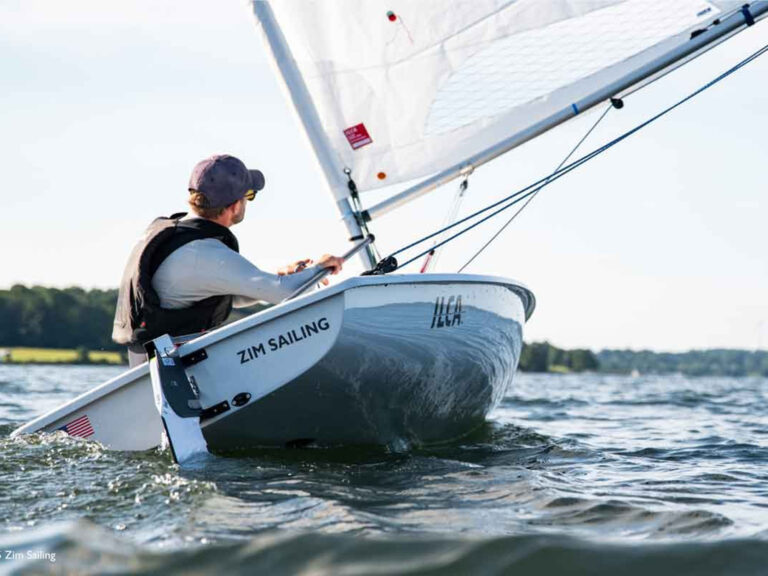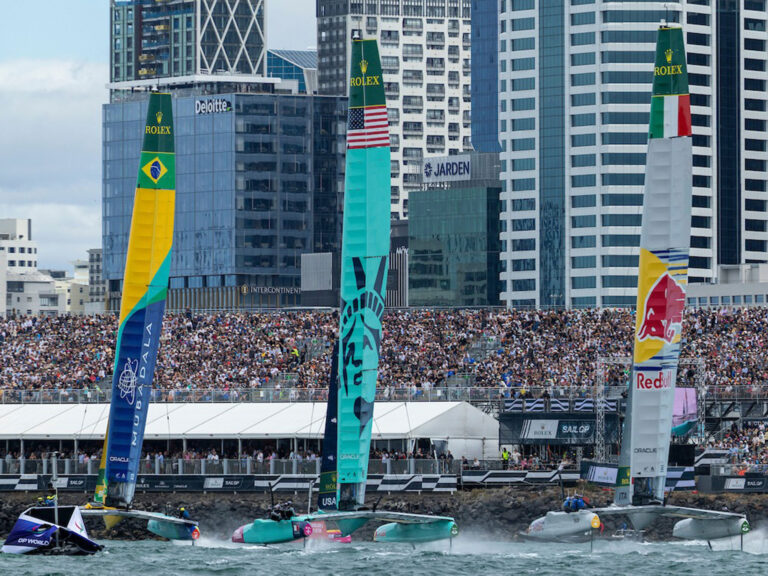Thirteen years ago on San Diego harbor, my wife and I tried out the breakthrough F-27 trimaran, designed by Ian Farrier and built by Corsair Marine. Its well-engineered folding mechanism and other trailering systems seemed remarkable then, and the boat’s performance in light air was smooth and quick. Fast forward to the summer of 2000: my wife, three daughters, and I are sailing a 31-foot version of that original in an 18-knot westerly on Buzzards Bay. We’ve left behind a quiet afternoon spent three boatlengths off an island beach, and now our sunning platform is rocketing upwind at 12 knots. I’m sitting out on the ama holding a 10-foot carbon tiller extension and clearing every wavetop with a big grin on my face. Rachel and the two older girls are in the cockpit. I peek down the hatch at one point, with the boat blasting through the waves, and catch the unforgettable sight of my youngest, Sophie, perched on the weather settee with her feet lightly braced against the carpeted daggerboard trunk-reading a book. It’s hard not to dwell on the extraordinary performance of the F-31 we sailed during a five-day cruise. From the foam-cored, vacuum-bagged hulls to the hardware and rotating aluminum spar, the boat seemed well built and rigged for speed. But the truth is we had only one high-speed day and never sailed the boat to its potential. Nonetheless, we discovered other benefits to sailing a quick boat. We left Wareham, Mass., on our first afternoon in a 7-knot breeze and jibed dead downwind for 14 miles under screecher (an overlapping, roller-furling reacher set on a sprit), then unrolled the jib to tack through the channel at Woods Hole; this took less than three hours. On our final day, with an even lighter wind, we sailed the 25 miles from Cuttyhunk Island to Wareham in less than four hours. The challenge is to utilize the 31’s horsepower in higher winds. I felt the boat could handle as much power as I wanted to use, but with a family crew, I quickly recognized that a certain responsibility comes with power and speed, and there was a learning curve to work up. The standard Corsair approach of equipping the boat with roller-furling devices gave me a good start. Except for the asymmetric spinnaker, which we didn’t use, all of the F-31’s sails roller-furled-even the mainsail, which rolls around the boom. The easiest way to sail shorthanded was to leave the main rolled up, which we did one day tacking out of Vineyard Haven under jib alone in a northeasterly. Without the stabilizing effect of the mainsail, the rotating mast slopped around, so I’m not sure this strategy would’ve been good in rough seas. But we soon bore off to the west, first reaching and then running, and the ride became relaxed. I realized I could use extra horsepower, so I unrolled the screecher and rolled up the jib. As we turned dead downwind, I unrolled the jib again and sailed wing and wing, chuckling to myself. It was a lousy, rainy day, and we were proceeding under good control, but I was still having a good time. Another day, we sailed under a deeply reefed main alone. This was a better sailing configuration, but to complete a tack in 20 knots and waves required close reaching at 10 knots, then throwing the tiller hard over. Also, getting the roller-furling main up and down required that Rachel learn to steer into the eye of the wind under outboard power. My 12-year-old, Isabel, handled the boom crank on the front of the mast (it links to the boom through the gooseneck) while I hauled up the halyard, using the winch for the last 10 feet. This was a lot easier in a quiet lee than when rolling and bouncing in an open seaway. Another lesson came as a squall approached us as we sailed up Vineyard Sound. Giving Rachel the helm, I blew the mainsheet, went forward and alternately eased the halyard and rolled up the main, but due to the wind pressure on the full-battened sail, I could go no farther than a deep reef. After the modest squall had passed, I realized that rather than continuing to sail under the jib, I should’ve dropped the outboard, rolled up the jib, and powered into the wind to drop themain. I also would’ve been happier if I’d started the whole process earlier. In terms of cruising accommodations, the F-31 has plenty to offer, but it’s not like staying at the Marriott. Then again, you won’t find a business convention-or many other boats-in the shallow spots we snuck into. In fact, more than anything, the boat’s shoal-draft ability was the defining feature of our cruise. The F-31’s rudder kicks up, and it has a daggerboard, which typically goes up and down without winch power. If you’re in extremely shallow water, you can pull both up and steer with the outboard alone, which draws only 2 feet. We enjoyed two nights in a quiet Martha’s Vineyard harbor called Lake Tashmoo with a shallow entrance. We spent one morning anchored with our stern to the beach in Vineyard Haven and waded ashore for breakfast. The next day we motored up an extremely shallow channel into beautiful Menemsha Pond at the west end of the Vineyard. After sailing over to the beach on Nashawena Island, we anchored in 3 feet of water for an afternoon of swimming and sun. And on our last night, we swung on our anchor in a part of crowded Cuttyhunk harbor where no other boats lay. Unlike a cruising catamaran, you live in the main hull on a trimaran such as the F-31. The hull’s narrow, but flares above the waterline providing room for settee berths and a V-berth forward along with 6’2″ standing headroom in the main cabin. The F-31 model we sailed had an “aft cabin” like the original F-27-a wide double berth you drop directly onto through a hatch behind the cockpit. The head is forward, under the aft part of the V-berth. (Other models have enclosed heads.) Our boat had a two-burner stove and plastic cooler under the step for the main hatch. Navigation was done with a ChartKit, and our electronics were handheld-VHF, cell phone, and GPS. The latter, in a holder belowdecks to starboard of the main hatch, could be swung into view to show our course and speed. We found lots of extra storage space outboard of the main hull. We carried an inflatable dinghy, lashed to the forward main beam, with its outboard and fuel jug lashed atop it. The oars lashed to the netting along the main cabin, and in the amas we stowed the anchors, rodes, boom tent, and other gear. In summary, the F-31’s biggest challenge for my relatively unschooled family crew was mastering the teamwork to raise and lower the roller-furling main. By week’s end the teamwork was coming together, and other details were becoming automatic for me-how to handle the steering lines rigged to the outboard, when to raise and lower the daggerboard, always making sure the rudder tie-down was securely cleated, etc. As I said earlier, in a breeze it seemed important to be a little conservative for the sake of the crew because the boat has a quick motion. At the same time, I’ll remind those readers who don’t sail multihulls regularly that even when full-power sailing, the boat hardly heels. It’s amazing to go below after a rigorous sail and find the kids’ boom box and Beanie Babies still perched on a shelf that has no restraining fiddle. What’s it like aboard an F-31 when you don’t have to coddle the crew? I raced aboard the boat one day last fall, crewing for one of the best Corsair sailors, Bob Gleason, owner of The Multihull Source dealership in Wareham. Unfortunately, we never saw more than 8 knots of wind, but I learned that in a knot or two of breeze you can sail faster than the windspeed. Flying the asymmetric with a racing crew of four was fun, too, and it turns out that finding the right tradeoff downwind between sailing hot and sailing deep applies just as it does in keelboats. The difference is, if you get it right in a keelboat you gain a few boatlengths over the course of a couple miles. In the F-31R, you gain a couple hundred yards. Still, fun’s a relative thing, and for the crew of multihull sailors I joined, this was pretty dull compared to their blazing spinnaker reach to the finish the previous day. Recalling that day I was cruising back on Buzzards Bay, I couldn’t help but agree. After sailing upwind until nearly past our destination, I’d pulled on the tiller, eased the main a few inches and the boat leaped to near 15 knots. The sun was warm, the spray peeling off the leeward hull, and I thought, “I wonder how much better 18 would feel?” Corsair F-31R LOA 30′ 10″ Beam 22′ 5″/8′ 2″ Draft 5′ 6″/1′ 4″ DPSL 3,400 lbs. Outboard 9.9 hp Corsair Marine 619-585-3005 www.corsairmarine.com





